Beyond the Flow: The Many Facets of Gazelle Valley Park (Jerusalem), an Urban Nature-Based Solution for Flood Mitigation in a Mediterranean Climate
Abstract
1. Introduction
1.1. The Potential of Nature-Based Solutions in the Urban Environment
1.2. Gazelle Valley Park, Jerusalem
2. Materials and Methods
2.1. The Urban Hydro-Ecological System of Gazelle Valley Park
2.2. Hydrometric Measurements
2.3. Geochemical Measurements
3. Results
3.1. Hydrological Measurements
3.2. Hydrochemical Dynamics
4. Discussion
4.1. Potential and Risk in Urban Stormwater and Reclaimed Wastewater
4.2. Urban Ecological Resilience
4.3. Education and Public Engagement
5. Conclusions
- Precipitation is linearly correlated with inflow volume (R2 = 0.95–0.96), as typically observed in urban environments, indicating that infiltration and storage processes play only a minor role in catchment hydrology.
- Runoff is generated even during relatively small rainfall events and low precipitation intensities, highlighting the high sensitivity of urban catchments with extensive impervious surfaces, which is critical for risk assessment under future climate scenarios.
- The mean runoff coefficient is lower than typical values for urban areas, reflecting the difficulty of accurately delineating runoff-generating zones in dense urban environments and the influence of subsurface drainage systems in diverting water outside topographic catchments.
- During summer, the introduction of reclaimed wastewater and rising temperatures (~7 °C to ~25 °C) reduce dissolved oxygen in small ponds, jeopardizing ecosystem stability resulting in dipteran larvae infestations.
- Most heavy metal pollution reaching GVP is adsorbed onto particles, emphasizing the need for improved filtration and particle-settling processes. The hydrological system of GVP reduces downstream pollution through the settling of particles and the water filtration.
- Incorporation of a biofilter or a combined clay-polymer filter within the park’s water system has the potential to enhance pollutant removal, reduce organic load, and improve oxygenation, thereby contributing to its ecosystem resilience.
- The park benefits substantially from its multi-disciplinary design and operation, where hydrology, ecology, education, and public engagement are integrated. By considering these many facets, the park demonstrates that “the whole is greater than the sum of its parts.”
Supplementary Materials
Author Contributions
Funding
Data Availability Statement
Acknowledgments
Conflicts of Interest
Abbreviations
| GVP | Gazelle Valley Park |
| SPNI | Society for the Protection of Nature in Israel |
| GSI | Geological Survey of Israel |
| NbSs | Nature-based Solutions |
References
- Carmon, N.; Shamir, U. Water-sensitive planning: Integrating water considerations into urban and regional planning. Water Environ. J. 2010, 24, 181–191. [Google Scholar] [CrossRef]
- Fletcher, T.D.; Andrieu, H.; Hamel, P. Understanding, management and modelling of urban hydrology and its consequences for receiving waters: A state of the art. Adv. Water Resour. 2013, 51, 261–279. [Google Scholar] [CrossRef]
- Fletcher, T.D.; Burns, M.J.; Russell, K.L.; Hamel, P.; Duchesne, S.; Cherqui, F.; Roy, A.H. Concepts and evolution of urban hydrology. Nat. Rev. Earth Environ. 2024, 5, 789–801. [Google Scholar] [CrossRef]
- Oswald, C.J.; Kelleher, C.; Ledford, S.H.; Hopkins, K.G.; Sytsma, A.; Tetzlaff, D.; Toran, L.; Voter, C. Integrating urban water fluxes and moving beyond impervious surface cover: A review. J. Hydrol. 2023, 618, 129188. [Google Scholar] [CrossRef]
- Chen, X.-L.; Zhao, H.-M.; Li, P.-X.; Yin, Z.-Y. Remote sensing image-based analysis of the relationship between urban heat island and land use/cover changes. Remote Sens. Environ. 2006, 104, 133–146. [Google Scholar] [CrossRef]
- Norton, B.A.; Coutts, A.M.; Livesley, S.J.; Harris, R.J.; Hunter, A.M.; Williams, N.S. Planning for cooler cities: A framework to prioritise green infrastructure to mitigate high temperatures in urban landscapes. Landsc. Urban Plan. 2015, 134, 127–138. [Google Scholar] [CrossRef]
- Yin, Z.; Liu, Z.; Liu, X.; Zheng, W.; Yin, L. Urban heat islands and their effects on thermal comfort in the US: New York and New Jersey. Ecol. Indic. 2023, 154, 110765. [Google Scholar] [CrossRef]
- Piracha, A.; Chaudhary, M.T. Urban air pollution, urban heat island and human health: A review of the literature. Sustainability 2022, 14, 9234. [Google Scholar] [CrossRef]
- Aris, A.Z.; Shamsuddin, A.S.; Praveena, S.M. Occurrence of 17α-ethynylestradiol (EE2) in the environment and effect on exposed biota: A review. Environ. Int. 2014, 69, 104–119. [Google Scholar] [CrossRef]
- Carey, R.O.; Hochmuth, G.J.; Martinez, C.J.; Boyer, T.H.; Dukes, M.D.; Toor, G.S.; Cisar, J.L. Evaluating nutrient impacts in urban watersheds: Challenges and research opportunities. Environ. Pollut. 2013, 173, 138–149. [Google Scholar] [CrossRef]
- Line, D.; White, N. Effects of development on runoff and pollutant export. Water Environ. Res. 2007, 79, 185–190. [Google Scholar] [CrossRef]
- Zinger, Y.; Deletic, A.; Fletcher, T.; Breen, P.; Wong, T. A dual-mode biofilter system: Case study in Kfar Sava, Israel. In Proceedings of the 12th International Conference on Urban Drainage, Porto Alegre, Brazil, 18–21 April 2011. [Google Scholar]
- Grodek, T.; Lange, J.; Lekach, J.; Husary, S. Urban hydrology in mountainous middle eastern cities. Hydrol. Earth Syst. Sci. 2011, 15, 953–966. [Google Scholar] [CrossRef]
- European Parliament Council. Directive 2000/60/EC—Water Framework Directive (WFD); European Parliament Council: Brussels, Belgium, 2000. Available online: https://eur-lex.europa.eu/eli/dir/2000/60/oj/eng (accessed on 12 October 2025).
- United States Congress. Clean Water Act; United States Congress: Washington, DC, USA, 1972. Available online: https://www.govinfo.gov/content/pkg/STATUTE-86/pdf/STATUTE-86-Pg816.pdf (accessed on 12 October 2025).
- State of Israel. Drainage and Flood Control Law, 5718-1957 (Israel); State of Israel: Jerusalem, Israel, 1957. Available online: https://faolex.fao.org/docs/pdf/isr4238E.pdf (accessed on 12 October 2025).
- State of Israel. Water Law, 5719-1959 (Israel); State of Israel: Jerusalem, Israel, 1959; Available online: https://faolex.fao.org/docs/pdf/isr1321.pdf (accessed on 12 October 2025).
- European Council. Council Directive 91/271/EEC—Urban Waste Water Treatment Directive (UWWTD); European Council: Brusseles, Belgium, 1991. Available online: https://eur-lex.europa.eu/legal-content/EN/ALL/?uri=celex%3A31991L0271 (accessed on 12 October 2025).
- European Parliament Council. Directive 2007/60/EC—Floods Directive; European Parliament Council: Brussels, Belgium, 2007. Available online: https://eur-lex.europa.eu/eli/dir/2007/60/oj (accessed on 12 October 2025).
- U.S. Environmental Protection Agency. EPA—Compendium of MS4 Permitting Approaches (Off-site Stormwater Management); U.S. Environmental Protection Agency: Washington, DC, USA, 2022. Available online: https://www.epa.gov/system/files/documents/2023-01/off-site-stormwater-management-MS4-compendium.pdf (accessed on 12 October 2025).
- U.S. Environmental Protection Agency. EPA—Stormwater Management Program (SWMP) Template; U.S. Environmental Protection Agency: Washington, DC, USA, 2019. Available online: https://www.epa.gov/sites/default/files/2019-06/documents/r10-npdes-pocatello-ua-ms4-ids028053-appendix-b1-swmp-template.pdf (accessed on 12 October 2025).
- U.S. Environmental Protection Agency. EPA—Stormwater Discharges from Municipal Sources (MS4 Guidance); U.S. Environmental Protection Agency: Washington, DC, USA, 2023. Available online: https://www.epa.gov/npdes/stormwater-discharges-municipal-sources (accessed on 12 October 2025).
- U.S. Environmental Protection Agency. EPA Stormwater Phase II Final Rule Fact Sheet Series; U.S. Environmental Protection Agency: Washington, DC, USA, 2005. Available online: https://www.epa.gov/npdes/stormwater-phase-ii-final-rule-fact-sheet-series (accessed on 12 October 2025).
- Tel Aviv-Yafo Municipality. Tel Aviv-Yafo Climate Adaptation Action Plan; Tel Aviv-Yafo Municipality: Tel Aviv, Israel, 2019. Available online: https://www.tel-aviv.gov.il/en/Documents/Climate%20Adaptation%20Action%20Plan.pdf (accessed on 12 October 2025).
- Israel Ministry of Environmental Protection. Climate Change Info Center—Plan Outline for Local Authorities (Israel Ministry of Environmental Protection); Israel Ministry of Environmental Protection: Jerusalem, Israel, 2013. Available online: https://www.gov.il/BlobFolder/reports/climate_change_info_center_report3/he/research_sviva_climate_change_climate_change_info_center_plan_outline_for_local_authorities_2013.pdf (accessed on 12 October 2025).
- Ashley, R.; Walker, L.; D’Arcy, B.; Wilson, S.; Illman, S.; Shaffer, P.; Woods-Ballard, B.; Chatfield, P. UK sustainable drainage systems: Past, present and future. Proc. Inst. Civ. Eng. Civ. Eng. 2015, 168, 125–130. [Google Scholar] [CrossRef]
- Shamir, U.; Carmon, N. Water-Sensitive Planning: Integrating Water Considerations into Urban and Regional Planning; Israel Institute of Technology (Technion): Haifa, Israel, 2007; p. 301. Available online: https://shamir.net.technion.ac.il/files/2012/03/water-sensitive-planning-book.pdf (accessed on 29 September 2022).
- Starkey, E.; Rollason, E.; Cotterill, S.; Sreenivas, P.; Bracken, L. Maximising urban resilience using sustainable drainage systems (SuDS): Making the case for community-led urban water management. Land Use Policy 2025, 158, 107732. [Google Scholar] [CrossRef]
- Kushnir, Y.; Dayan, U.; Ziv, B.; Morin, E.; Enzel, Y. Climate of the Levant. In Quaternary of the Levant; Enzel, Y., Bar-Yosef, O., Eds.; Cambridge University Press: Cambridge, UK, 2017; pp. 31–44. [Google Scholar] [CrossRef]
- Ben Dor, Y.; Armon, M.; Ahlborn, M.; Morin, E.; Erel, Y.; Brauer, A.; Schwab, M.J.; Tjallingii, R.; Enzel, Y. Changing flood frequencies under opposing late Pleistocene eastern Mediterranean climates. Sci. Rep. 2018, 8, 8445. [Google Scholar] [CrossRef] [PubMed]
- Marra, F.; Armon, M.; Adam, O.; Zoccatelli, D.; Gazal, O.; Garfinkel, C.I.; Rostkier-Edelstein, D.; Dayan, U.; Enzel, Y.; Morin, E. Toward Narrowing Uncertainty in Future Projections of Local Extreme Precipitation. Geophys. Res. Lett. 2021, 48, e2020GL091823. [Google Scholar] [CrossRef]
- Morin, E.; Harats, N.; Jacoby, Y.; Arbel, S.; Getker, M.; Arazi, A.; Grodek, T.; Ziv, B.; Dayan, U. Studying the extremes: Hydrometeorological investigation of a flood-causing rainstorm over Israel. Adv. Geosci. 2007, 12, 107–114. [Google Scholar] [CrossRef]
- Armon, M.; Marra, F.; Enzel, Y.; Rostkier-Edelstein, D.; Garfinkel, C.I.; Adam, O.; Dayan, U.; Morin, E. Reduced rainfall in future heavy precipitation events related to contracted rain area despite increased rain rate. Earth’s Future 2022, 10, e2021EF002397. [Google Scholar] [CrossRef]
- Hochman, A.; Mercogliano, P.; Alpert, P.; Saaroni, H.; Bucchignani, E. High-resolution projection of climate change and extremity over Israel using COSMO-CLM. Int. J. Climatol. 2018, 38, 5095–5106. [Google Scholar] [CrossRef]
- Hochman, A.; Alpert, P.; Kunin, P.; Rostkier-Edelstein, D.; Harpaz, T.; Saaroni, H.; Messori, G. The dynamics of cyclones in the 21st century: The Eastern Mediterranean as an example. Clim. Dyn. 2020, 54, 561–574. [Google Scholar] [CrossRef]
- Reale, M.; Cabos Narvaez, W.D.; Cavicchia, L.; Conte, D.; Coppola, E.; Flaounas, E.; Giorgi, F.; Gualdi, S.; Hochman, A.; Li, L. Future projections of Mediterranean cyclone characteristics using the Med-CORDEX ensemble of coupled regional climate system models. Clim. Dyn. 2022, 58, 2501–2524. [Google Scholar] [CrossRef]
- Yosef, Y.; Aguilar, E.; Alpert, P. Changes in extreme temperature and precipitation indices: Using an innovative daily homogenized database in Israel. Int. J. Climatol. 2019, 39, 5022–5045. [Google Scholar] [CrossRef]
- Zappa, G.; Hawcroft, M.K.; Shaffrey, L.; Black, E.; Brayshaw, D.J. Extratropical cyclones and the projected decline of winter Mediterranean precipitation in the CMIP5 models. Clim. Dyn. 2015, 45, 1727–1738. [Google Scholar] [CrossRef]
- Beck, H.E.; McVicar, T.R.; Vergopolan, N.; Berg, A.; Lutsko, N.J.; Dufour, A.; Zeng, Z.; Jiang, X.; van Dijk, A.I.; Miralles, D.G. High-resolution (1 km) Köppen-Geiger maps for 1901–2099 based on constrained CMIP6 projections. Sci. Data 2023, 10, 724. [Google Scholar] [CrossRef]
- Saaroni, H.; Ben-Dor, E.; Bitan, A.; Potchter, O. Spatial distribution and microscale characteristics of the urban heat island in Tel-Aviv, Israel. Landsc. Urban Plan. 2000, 48, 1–18. [Google Scholar] [CrossRef]
- Zalewski, M.; Kiedrzyńska, E.; Wagner, I.; Izydorczyk, K.; Boczek, J.M.; Jurczak, T.; Krauze, K.; Frankiewicz, P.; Godlewska, M.; Wojtal-Frankiewicz, A. Ecohydrology and adaptation to global change. Ecohydrol. Hydrobiol. 2021, 21, 393–410. [Google Scholar] [CrossRef]
- European Environment Agency. Nature-Based Solutions in Europe Policy, Knowledge and Practice for Climate Change Adaptation and Disaster Risk Reduction; European Environment Agency Publications Office: Copenhagen, Denmark, 2021. Available online: https://data.europa.eu/doi/10.2800/919315 (accessed on 12 October 2025). [CrossRef]
- Esraz-Ul-Zannat, M.; Dedekorkut-Howes, A.; Morgan, E.A. A review of nature-based infrastructures and their effectiveness for urban flood risk mitigation. Wiley Interdiscip. Rev. Clim. Change 2024, 15, e889. [Google Scholar] [CrossRef]
- Ruangpan, L.; Vojinovic, Z.; Di Sabatino, S.; Leo, L.S.; Capobianco, V.; Oen, A.M.; McClain, M.E.; Lopez-Gunn, E. Nature-based solutions for hydro-meteorological risk reduction: A state-of-the-art review of the research area. Nat. Hazards Earth Syst. Sci. 2020, 20, 243–270. [Google Scholar] [CrossRef]
- Huang, Y.; Tian, Z.; Ke, Q.; Liu, J.; Irannezhad, M.; Fan, D.; Hou, M.; Sun, L. Nature-based solutions for urban pluvial flood risk management. Wiley Interdiscip. Rev. Water 2020, 7, e1421. [Google Scholar] [CrossRef]
- Goulden, S.; Portman, M.E.; Carmon, N.; Alon-Mozes, T. From conventional drainage to sustainable stormwater management: Beyond the technical challenges. J. Environ. Manag. 2018, 219, 37–45. [Google Scholar] [CrossRef] [PubMed]
- Kiedrzyńska, E.; Belka, K.; Jarosiewicz, P.; Kiedrzyński, M.; Zalewski, M. The enhancement of valley water retentiveness in climate change conditions. Sci. Total Environ. 2021, 799, 149427. [Google Scholar] [CrossRef]
- Markus, L.; Gazit, A.; Carmon, N. The Use of Road Runoff for Ecological and Societal Benefits by Water-Sensitive Planning. 2015, pp. 8–15. Available online: https://www.researchgate.net/publication/319182886_symws_bngr_kbysym_lhsgt_twlwt_qwlwgywt_whbrtywt_bmzwt_yyswm_qrwnwt_trm_-_tknwn_rgys_lmym (accessed on 12 October 2025).
- Polyakov, M.; Iftekhar, S.; Zhang, F.; Fogarty, J. The amenity value of water sensitive urban infrastructure: A case study on rain gardens. In Proceedings of the 9th IWA Symposium on Systems Analysis and Integrated Assessment, Gold Coast, Australia, 14–17 June 2015. [Google Scholar]
- Sun, C.; Rao, Q.; Chen, B.; Liu, X.; Adnan Ikram, R.M.; Li, J.; Wang, M.; Zhang, D. Mechanisms and applications of nature-based solutions for stormwater control in the context of climate change: A review. Atmosphere 2024, 15, 403. [Google Scholar] [CrossRef]
- Sánchez-García, C.; Corvacho-Ganahín, Ó.; Santasusagna Riu, A.; Francos, M. Nature-Based Solutions (NbSs) to Improve Flood Preparedness in Barcelona Metropolitan Area (Northeastern Spain). Hydrology 2024, 11, 213. [Google Scholar] [CrossRef]
- Bookman, S. A discussion on the topic of utilizing urban runoff water. Ecol. Environ. 2017, 8, 83–92. [Google Scholar]
- JNF. Urban Runoff Management and Reclamation in Water-Sensitive Cities; JNF: Jerusalem, Israel, 2017; Available online: https://wsc.org.il/wp-content/uploads/2018/08/17_Book_Web.pdf (accessed on 29 September 2022).
- Zinger, Y. A step towards water-sensitive cities in Israel; The Kfar Saba biofilter. Ecol. Environ. 2015, 6. [Google Scholar]
- Rosmadi, H.S.B.; Ahmed, M.F.; Mokhtar, M.B.; Halder, B.; Scholz, M. Nature-Based Solutions (NbS) for Flood Management in Malaysia. Water 2024, 16, 3606. [Google Scholar] [CrossRef]
- Blecken, G.T.; Zinger, Y.; Deletić, A.; Fletcher, T.D.; Viklander, M. Influence of intermittent wetting and drying conditions on heavy metal removal by stormwater biofilters. Water Res. 2009, 43, 4590–4598. [Google Scholar] [CrossRef]
- Izydorczyk, K.; Piniewski, M.; Krauze, K.; Courseau, L.; Czyż, P.; Giełczewski, M.; Kardel, I.; Marcinkowski, P.; Szuwart, M.; Zalewski, M. The ecohydrological approach, SWAT modelling, and multi-stakeholder engagement–A system solution to diffuse pollution in the Pilica basin, Poland. J. Environ. Manag. 2019, 248, 109329. [Google Scholar] [CrossRef]
- Zalewski, M. Ecohydrology for implementation of the EU water framework directive. In Proceedings of the Institution of Civil Engineers-Water Management; Emerald Publishing: Leeds, UK, 2011; pp. 375–385. [Google Scholar]
- Zinger, Y.; Blecken, G.-T.; Fletcher, T.D.; Viklander, M.; Deletić, A. Optimising nitrogen removal in existing stormwater biofilters: Benefits and tradeoffs of a retrofitted saturated zone. Ecol. Eng. 2013, 51, 75–82. [Google Scholar] [CrossRef]
- The Gazelle Valley Paek Planning Team. Master Plan for Gazelle Valley; The Gazelle Valley Paek Planning Team: Jerusalem, Israel, 2005. [Google Scholar]
- Alon-Mozes, T.; Erl, E.; Berner, A.; Daltik, A.; Wallach, R.; Friedler, E. Management and reutilization of runoff in a water-sensitive sity; from nuisance to resource. Soil 2017, 76, 94. [Google Scholar]
- Belkin, O.L. First Place for Gazelle Valley Park in the Caravan Award for Garden and Landscape Architecture. Legit Magazine, 4 July 2019. [Google Scholar]
- Rinat, T. Jerusalem’s Gazelle Valley Park Prevents Flooding and Demonstrates Natural Coping with the Climate Crisis. HaAretz. 4 October 2021. Available online: https://www.haaretz.co.il/nature/climate/2021-10-04/ty-article/.highlight/0000017f-dc58-d3a5-af7f-fefe385e0000 (accessed on 1 September 2025).
- Cohen-Shacham, E.; Walters, G.; Janzen, C.; Maginnis, S. Nature-Based Solutions to Address Global Societal Challenges; IUCN: Gland, Switzerland, 2016; Volume 97, pp. 2016–2036.
- Reuven, Y. The Gazelle Valley Park in Jerusalem Stars in the State of Israel’s Promotional Video Presented at the UN. Kol Ha-Ir 2019. Available online: https://www.kolhair.co.il/jerusalem-news/98463 (accessed on 1 September 2025).
- Ganot, N.; Kedem, A.; Hazofe, O.; Erez, M.; Avni-Magen, N. A project to strengthen ferruginous duck (Aythya nyroca) population in Israel through re-entry into the wild from the Biblical Zoo. Ecol. Environ. 2022, 13. [Google Scholar]
- Avisar, D.; Lester, Y.; Ronen, D. Sulfamethoxazole contamination of a deep phreatic aquifer. Sci. Total Environ. 2009, 407, 4278–4282. [Google Scholar] [CrossRef]
- Fuhrman, V.F.; Tal, A.; Arnon, S. Why endocrine disrupting chemicals (EDCs) challenge traditional risk assessment and how to respond. J. Hazard. Mater. 2015, 286, 589–611. [Google Scholar] [CrossRef] [PubMed]
- Malchi, T.; Maor, Y.; Tadmor, G.; Shenker, M.; Chefetz, B. Irrigation of root vegetables with treated wastewater: Evaluating uptake of pharmaceuticals and the associated human health risks. Environ. Sci. Technol. 2014, 48, 9325–9333. [Google Scholar] [CrossRef]
- Chow, V.T. Open Channel Hydraulics; McGraw-Hill: New York, NY, USA, 1959. [Google Scholar]
- Saaroni, H.; Halfon, N.; Ziv, B.; Alpert, P.; Kutiel, H. Links between the rainfall regime in Israel and location and intensity of Cyprus lows. Int. J. Climatol. 2010, 30, 1014–1025. [Google Scholar] [CrossRef]
- The National Environmental Health System in Public Health Services. Public Health Regulations (Sanitary Quality of Drinking Water and Drinking Water Facilities); The National Environmental Health System in Public Health Services, Ministry of Health: Jerusalem, Israel, 2013. Available online: https://www.nevo.co.il/law_html/law00/125912.htm (accessed on 17 March 2025).
- Li, Z.; Wu, L.; Zhu, W.; Hou, M.; Yang, Y.; Zheng, J. A new method for urban storm flood inundation simulation with fine CD-TIN surface. Water 2014, 6, 1151–1171. [Google Scholar] [CrossRef]
- Vrebos, D.; Vansteenkiste, T.; Staes, J.; Willems, P.; Meire, P. Water displacement by sewer infrastructure in the Grote Nete catchment, Belgium, and its hydrological regime effects. Hydrol. Earth Syst. Sci. 2014, 18, 1119–1136. [Google Scholar] [CrossRef]
- Birkinshaw, S.J.; O’Donnell, G.; Glenis, V.; Kilsby, C. Improved hydrological modelling of urban catchments using runoff coefficients. J. Hydrol. 2021, 594, 125884. [Google Scholar] [CrossRef]
- Martín Muñoz, S.; Elliott, S.; Schoelynck, J.; Staes, J. Urban stormwater management using nature-based solutions: A review and conceptual model of floodable parks. Land 2024, 13, 1858. [Google Scholar] [CrossRef]
- Gaufin, A.R.; Tarzwell, C.M. Aquatic invertebrates as indicators of stream pollution. Public Health Rep. 1952, 67, 57. [Google Scholar] [CrossRef]
- Zhang, K.; Barron, N.J.; Zinger, Y.; Hatt, B.; Prodanovic, V.; Deletic, A. Pollutant removal performance of field scale dual-mode biofilters for stormwater, greywater, and groundwater treatment. Ecol. Eng. 2021, 163, 106192. [Google Scholar] [CrossRef]
- Shabtai, I.A.; Lynch, L.M.; Mishael, Y.G. Designing clay-polymer nanocomposite sorbents for water treatment: A review and meta-analysis of the past decade. Water Res. 2021, 188, 116571. [Google Scholar] [CrossRef] [PubMed]
- Zusman, O.B.; Kummel, M.L.; José, M.; Mishael, Y.G. Dissolved organic matter adsorption from surface waters by granular composites versus granular activated carbon columns: An applicable approach. Water Res. 2020, 181, 115920. [Google Scholar] [CrossRef] [PubMed]


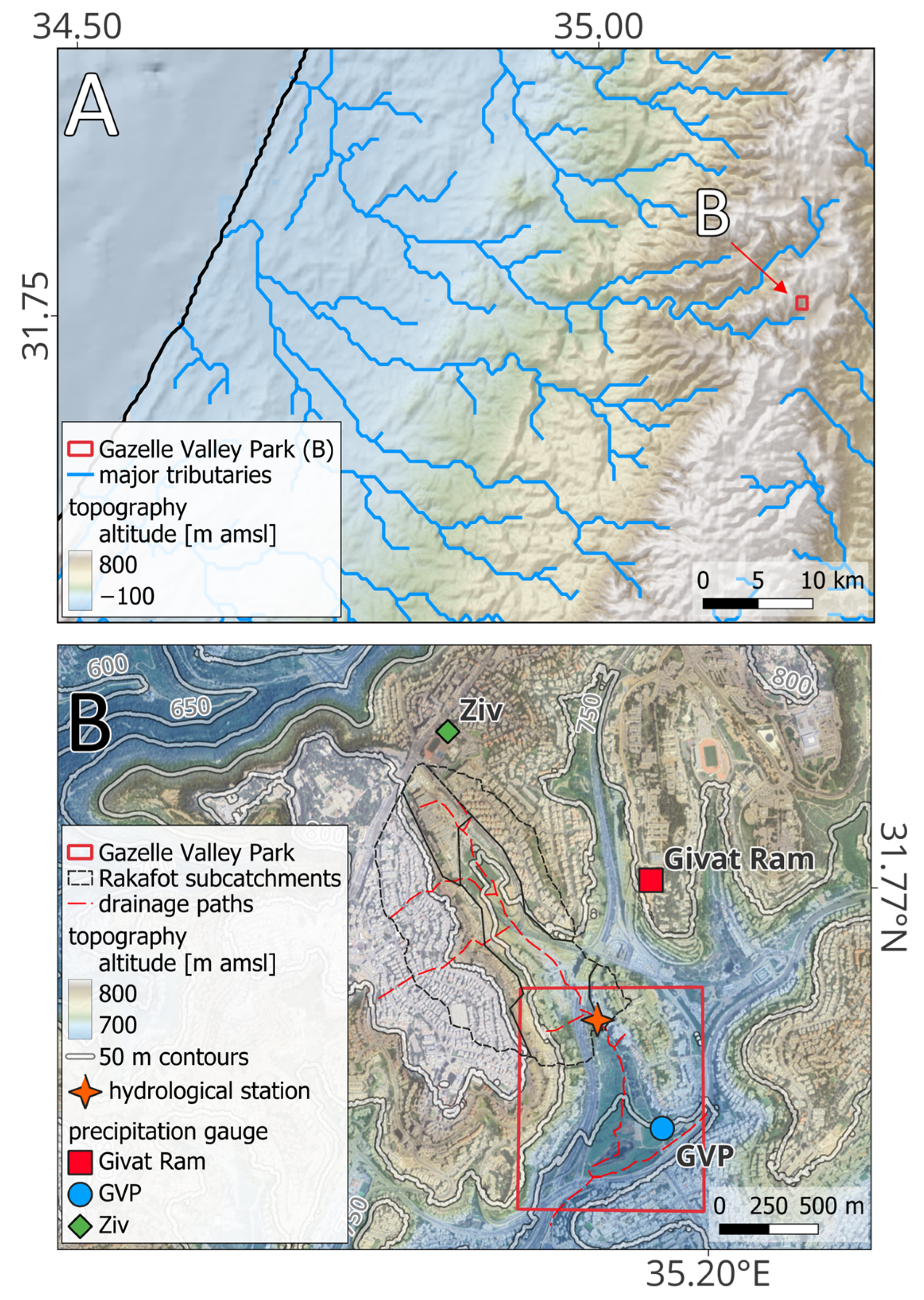


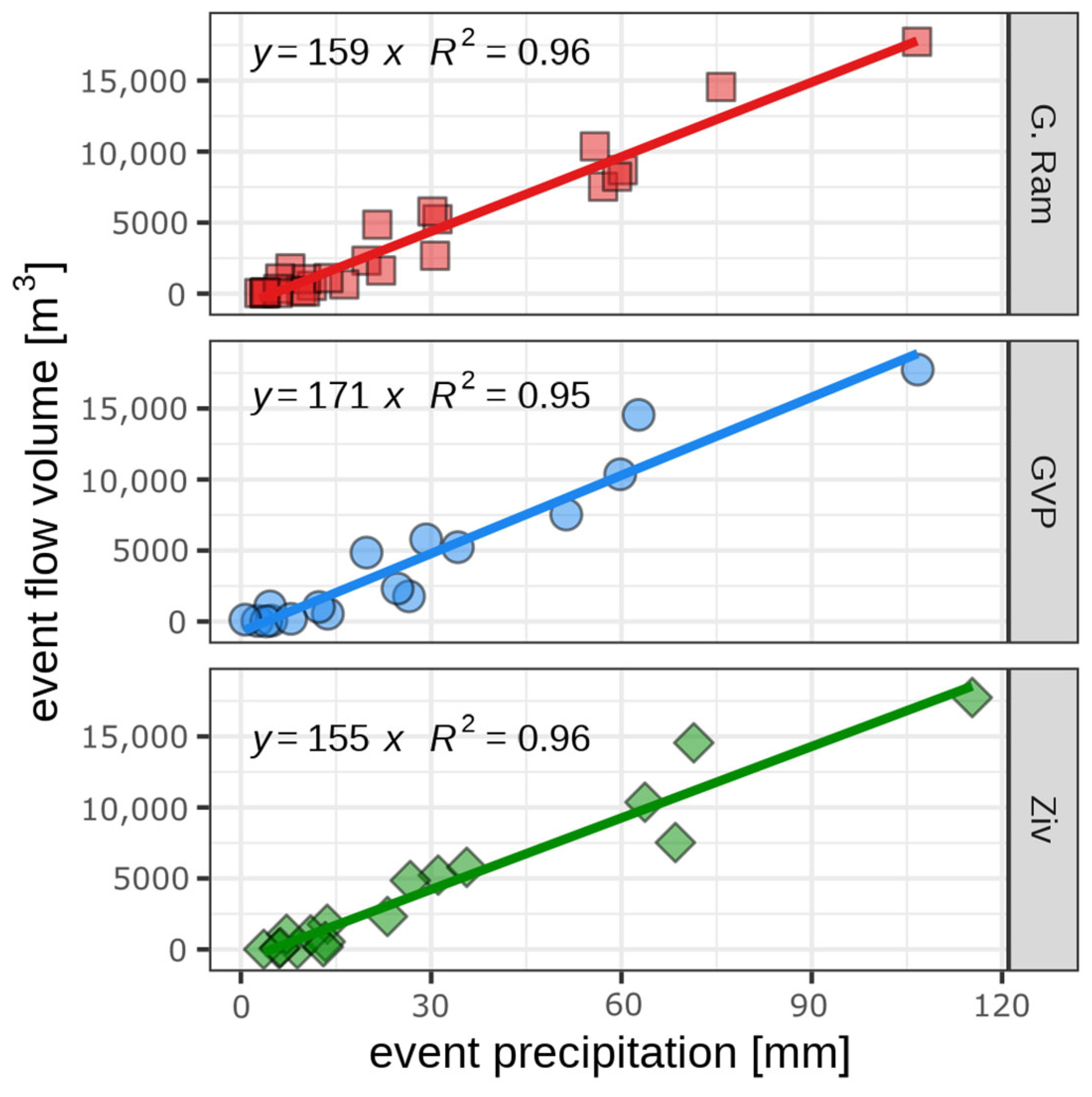
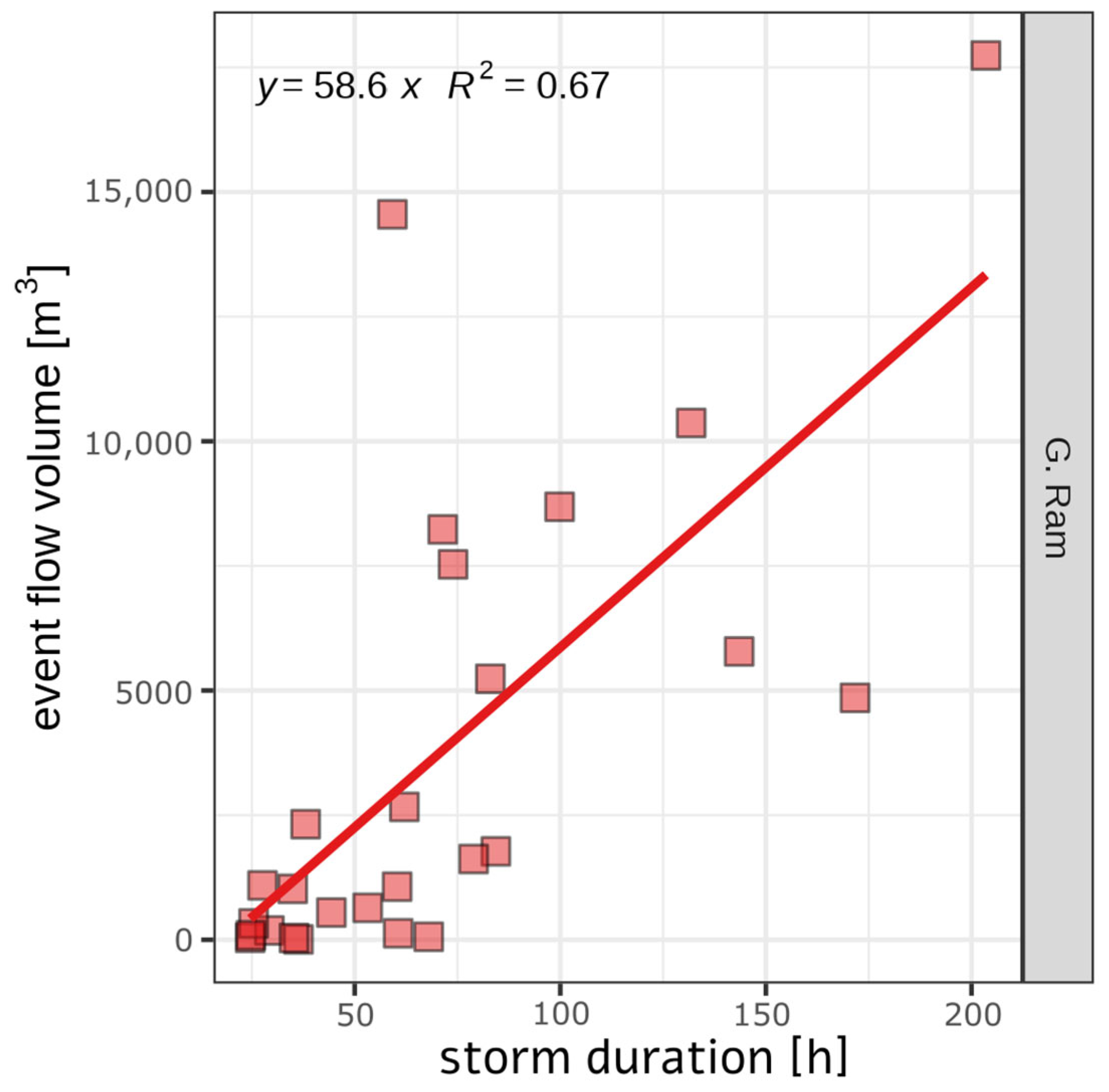


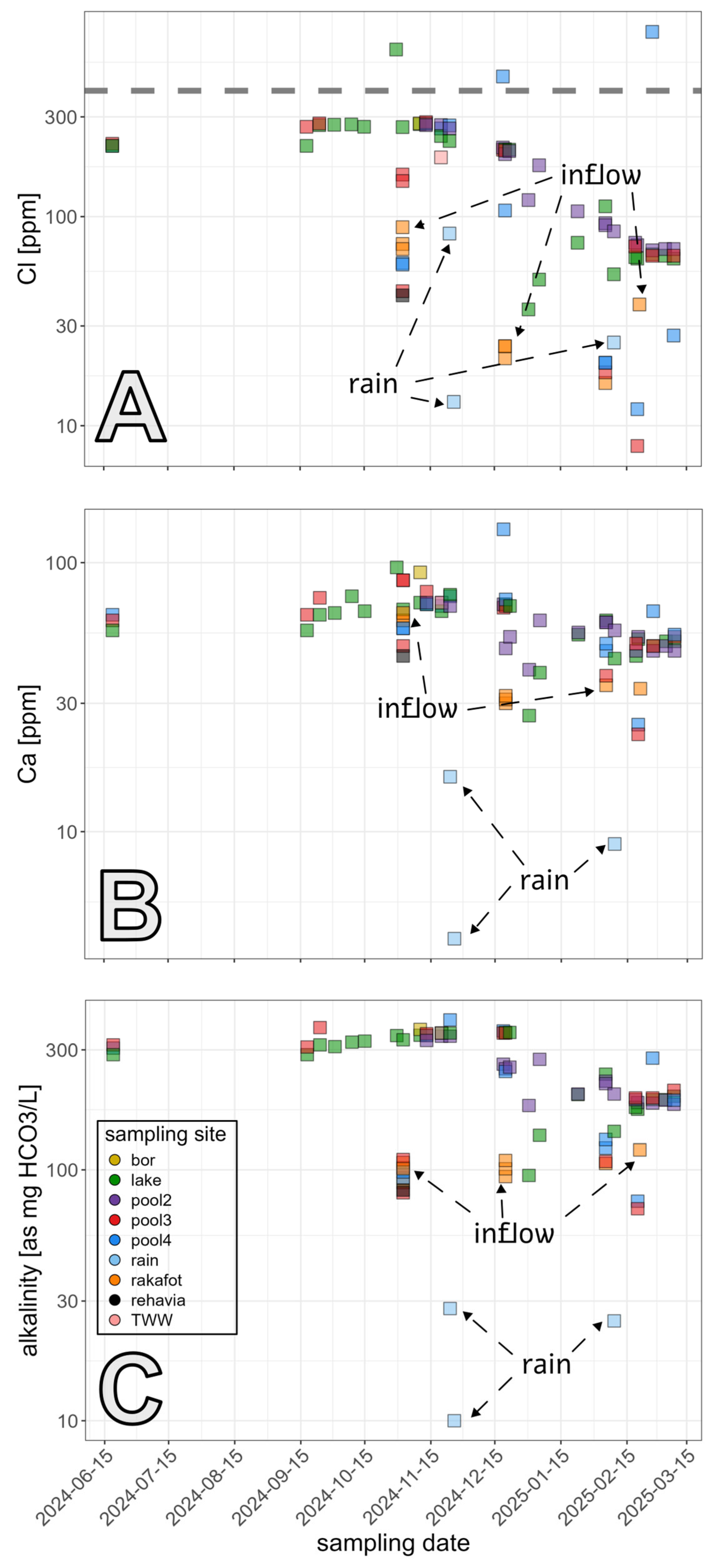

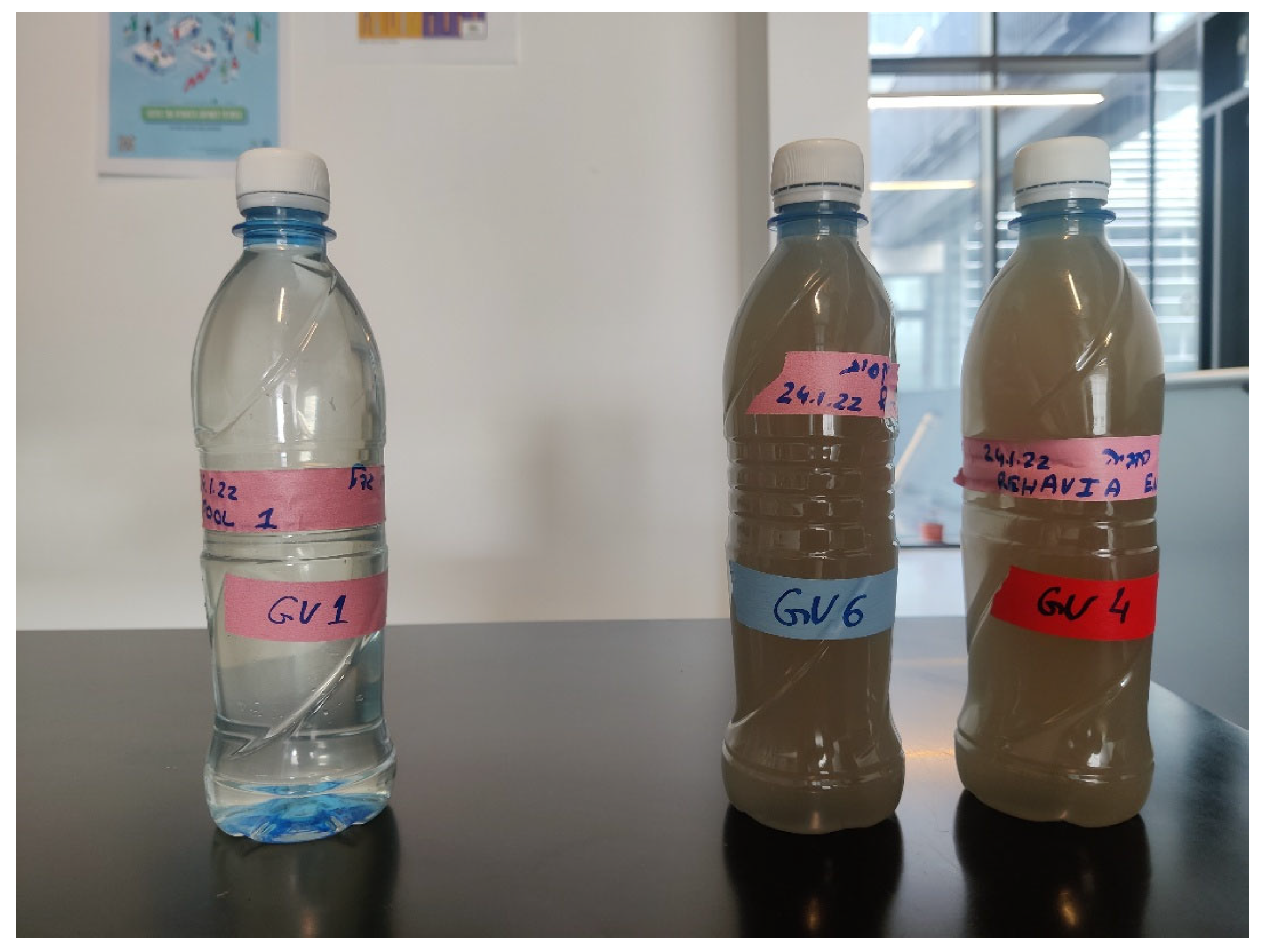
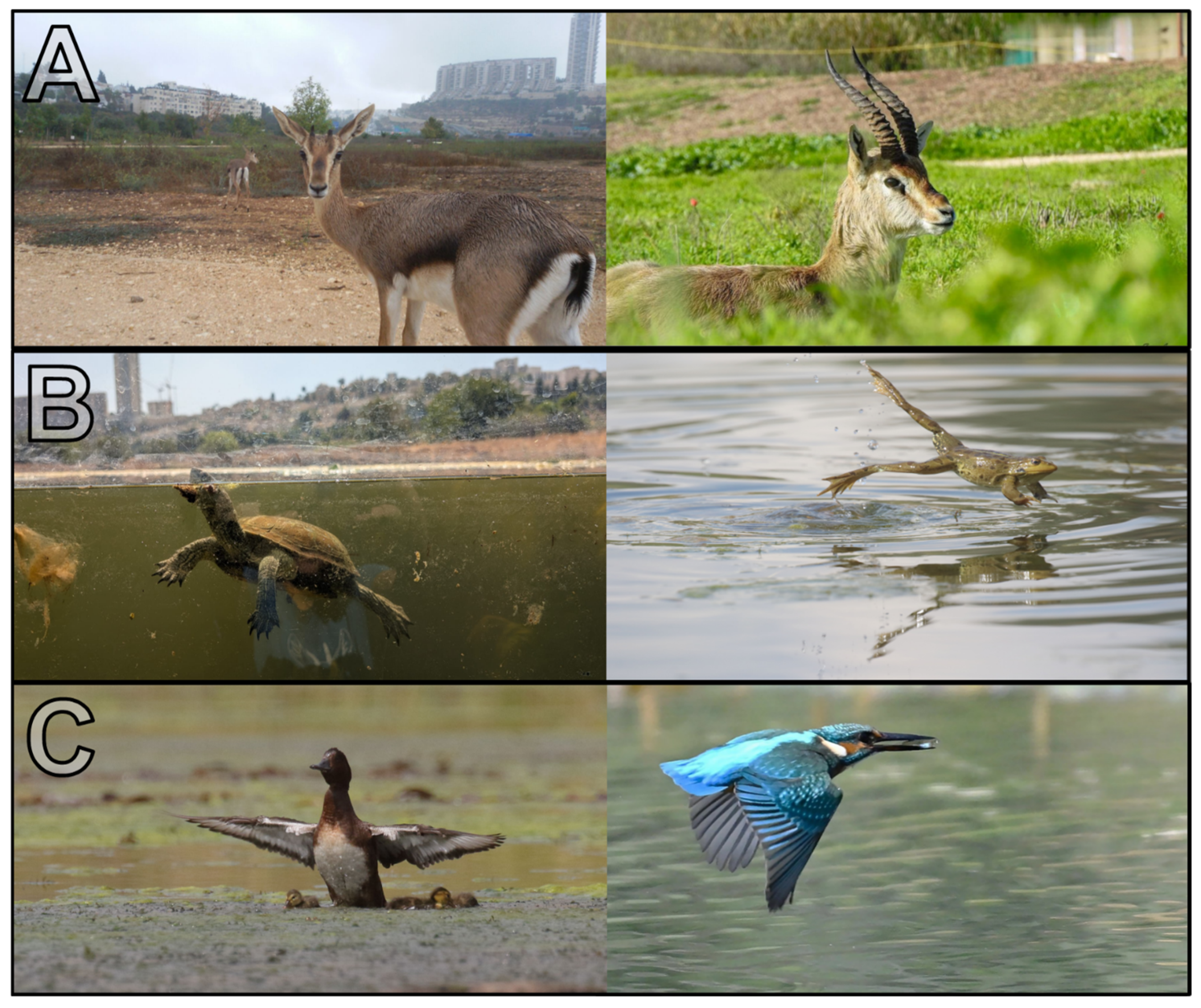

Disclaimer/Publisher’s Note: The statements, opinions and data contained in all publications are solely those of the individual author(s) and contributor(s) and not of MDPI and/or the editor(s). MDPI and/or the editor(s) disclaim responsibility for any injury to people or property resulting from any ideas, methods, instructions or products referred to in the content. |
© 2025 by the authors. Licensee MDPI, Basel, Switzerland. This article is an open access article distributed under the terms and conditions of the Creative Commons Attribution (CC BY) license (https://creativecommons.org/licenses/by/4.0/).
Share and Cite
Ben Dor, Y.; Sharabi, G.; Nussbaum, R.; Alian, S.; Morin, E.; Freiman, E.; Lind, A.; Shemesh, I.; Balaban, A.; Ozinsky, R.; et al. Beyond the Flow: The Many Facets of Gazelle Valley Park (Jerusalem), an Urban Nature-Based Solution for Flood Mitigation in a Mediterranean Climate. Land 2025, 14, 2174. https://doi.org/10.3390/land14112174
Ben Dor Y, Sharabi G, Nussbaum R, Alian S, Morin E, Freiman E, Lind A, Shemesh I, Balaban A, Ozinsky R, et al. Beyond the Flow: The Many Facets of Gazelle Valley Park (Jerusalem), an Urban Nature-Based Solution for Flood Mitigation in a Mediterranean Climate. Land. 2025; 14(11):2174. https://doi.org/10.3390/land14112174
Chicago/Turabian StyleBen Dor, Yoav, Galit Sharabi, Raz Nussbaum, Sabri Alian, Efrat Morin, Elyasaf Freiman, Amanda Lind, Inbal Shemesh, Amir Balaban, Rami Ozinsky, and et al. 2025. "Beyond the Flow: The Many Facets of Gazelle Valley Park (Jerusalem), an Urban Nature-Based Solution for Flood Mitigation in a Mediterranean Climate" Land 14, no. 11: 2174. https://doi.org/10.3390/land14112174
APA StyleBen Dor, Y., Sharabi, G., Nussbaum, R., Alian, S., Morin, E., Freiman, E., Lind, A., Shemesh, I., Balaban, A., Ozinsky, R., & Levintal, E. (2025). Beyond the Flow: The Many Facets of Gazelle Valley Park (Jerusalem), an Urban Nature-Based Solution for Flood Mitigation in a Mediterranean Climate. Land, 14(11), 2174. https://doi.org/10.3390/land14112174






